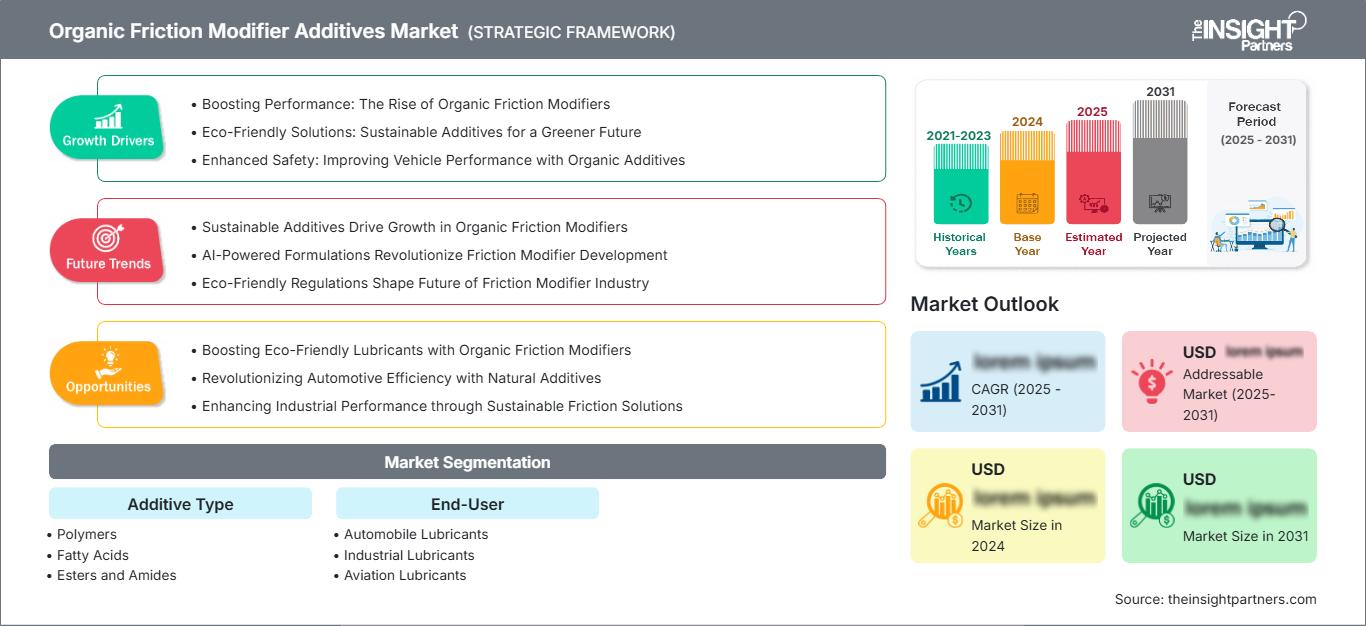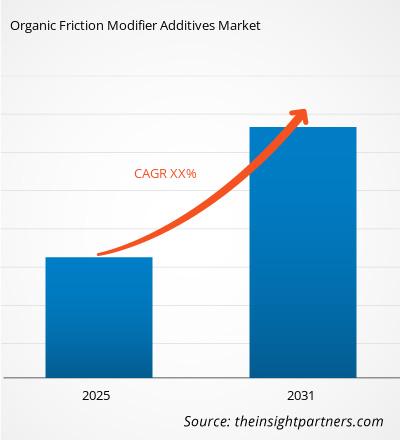Le marché des additifs organiques modificateurs de friction devrait connaître une croissance soutenue entre 2026 et 2034. Sa valeur devrait augmenter par rapport à son niveau de référence de 2025 et poursuivre son expansion jusqu'à la fin de la période de prévision. Cette tendance reflète des perspectives de marché favorables, portées par l'évolution des besoins du secteur et les progrès technologiques constants.
Le rapport est structuré par type d'additif (polymères, acides gras, esters et amides) et analyse le marché en fonction de l'utilisateur final (lubrifiants automobiles, industriels, aéronautiques, pour la production d'énergie et ferroviaires). Une ventilation détaillée est fournie aux niveaux mondial, régional et national pour chacun de ces segments clés.
Le rapport inclut la taille du marché et les prévisions pour tous les segments, exprimées en dollars américains. Il présente également des statistiques essentielles sur la position actuelle des principaux acteurs du marché, ainsi que des informations sur les tendances actuelles et les opportunités émergentes.
Objectif du rapport
Le rapport « Marché des additifs modificateurs de friction organiques » de The Insight Partners vise à décrire le paysage actuel et la croissance future, les principaux facteurs de croissance, les défis et les opportunités. Il fournira des informations précieuses à divers acteurs du secteur, tels que :
- Fournisseurs de technologies/Fabricants : Pour comprendre l’évolution de la dynamique du marché et connaître les opportunités de croissance potentielles, afin de prendre des décisions stratégiques éclairées.
- Investisseurs : Réaliser une analyse complète des tendances concernant le taux de croissance du marché, les projections financières du marché et les opportunités existantes tout au long de la chaîne de valeur.
- Organismes de réglementation : Réglementer les politiques et les activités de police sur le marché afin de minimiser les abus, de préserver la confiance des investisseurs et de maintenir l’intégrité et la stabilité du marché.
Segmentation du marché des additifs modificateurs de friction organiques : Type d’additif
- Polymères
- Acides gras
- Esters et amides
Utilisateur final
- Lubrifiants automobiles
- Lubrifiants industriels
- Lubrifiants aéronautiques
- Lubrifiants pour la production d'énergie/d'électricité
- Lubrifiants pour rails
Vous bénéficierez d'une personnalisation gratuite de tous les rapports, y compris certaines parties de ce rapport, l'analyse par pays, le pack de données Excel, et vous profiterez également d'offres et de réductions exceptionnelles pour les start-ups et les universités.
Marché des additifs modificateurs de friction organiques : perspectives stratégiques

-
Découvrez les principales tendances du marché présentées dans ce rapport.Cet échantillon GRATUIT comprendra une analyse de données, allant des tendances du marché aux estimations et prévisions.
Facteurs de croissance du marché des additifs modificateurs de friction organiques
- Amélioration des performances : l’essor des modificateurs de friction organiques
- Solutions écologiques : des additifs durables pour un avenir plus vert
- Sécurité renforcée : Amélioration des performances du véhicule grâce aux additifs organiques
Tendances futures du marché des additifs modificateurs de friction organiques
- Les additifs durables stimulent la croissance des modificateurs de friction organiques
- Les formulations basées sur l'IA révolutionnent le développement des modificateurs de friction
- Des réglementations respectueuses de l'environnement façonnent l'avenir de l'industrie des modificateurs de friction
Opportunités de marché des additifs modificateurs de friction organiques
- Amélioration des lubrifiants écologiques grâce à des modificateurs de friction organiques
- Révolutionner l'efficacité automobile grâce aux additifs naturels
- Amélioration des performances industrielles grâce à des solutions de friction durables
Analyse régionale du marché des additifs modificateurs de friction organiques
Les tendances régionales et les facteurs influençant le marché des additifs modificateurs de friction organiques tout au long de la période prévisionnelle ont été analysés en détail par les analystes de The Insight Partners. Cette section aborde également les segments de marché et la répartition géographique des additifs modificateurs de friction organiques en Amérique du Nord, en Europe, en Asie-Pacifique, au Moyen-Orient et en Afrique, ainsi qu'en Amérique du Sud et centrale.
Portée du rapport sur le marché des additifs modificateurs de friction organiques
| Attribut du rapport | Détails |
|---|---|
| Taille du marché en 2025 | XX millions de dollars américains |
| Taille du marché d'ici 2034 | XX millions de dollars américains |
| TCAC mondial (2026 - 2034) | XX% |
| Données historiques | 2021-2024 |
| Période de prévision | 2026-2034 |
| Segments couverts |
Par type d'additif
|
| Régions et pays couverts |
Amérique du Nord
|
| Leaders du marché et profils d'entreprises clés |
|
Acteurs du marché des additifs modificateurs de friction organiques : Densité : Comprendre son impact sur la dynamique commerciale
Le marché des additifs organiques modificateurs de friction connaît une croissance rapide, portée par une demande croissante des utilisateurs finaux. Cette demande est alimentée par l'évolution des préférences des consommateurs, les progrès technologiques et une meilleure connaissance des avantages du produit. Face à cette demande grandissante, les entreprises élargissent leur offre, innovent pour répondre aux besoins des consommateurs et tirent parti des tendances émergentes, ce qui contribue à la croissance du marché.

- Découvrez un aperçu des principaux acteurs du marché des additifs modificateurs de friction organiques.
Points clés de vente
- Couverture exhaustive : Le rapport couvre de manière exhaustive l’analyse des produits, services, types et utilisateurs finaux du marché des additifs modificateurs de friction organiques, offrant ainsi une vue d’ensemble.
- Analyse d'experts : Ce rapport est établi sur la base d'une compréhension approfondie des experts et analystes du secteur.
- Informations à jour : Ce rapport garantit sa pertinence commerciale grâce à sa couverture des informations et tendances récentes en matière de données.
- Options de personnalisation : Ce rapport peut être personnalisé pour répondre aux exigences spécifiques du client et s’adapter parfaitement aux stratégies commerciales.
Le rapport d'étude de marché sur les additifs modificateurs de friction organiques peut donc contribuer à décrypter et à comprendre le contexte sectoriel et les perspectives de croissance. Malgré quelques points à améliorer, les avantages de ce rapport l'emportent généralement sur les inconvénients.
- Analyse historique (2 ans), année de base, prévision (7 ans) avec TCAC
- Analyse PEST et SWOT
- Taille du marché Valeur / Volume - Mondial, Régional, Pays
- Industrie et paysage concurrentiel
- Ensemble de données Excel
Rapports récents
Rapports connexes
Témoignages
Raison d'acheter
- Prise de décision éclairée
- Compréhension de la dynamique du marché
- Analyse concurrentielle
- Connaissances clients
- Prévisions de marché
- Atténuation des risques
- Planification stratégique
- Justification des investissements
- Identification des marchés émergents
- Amélioration des stratégies marketing
- Amélioration de l'efficacité opérationnelle
- Alignement sur les tendances réglementaires






















 Obtenez un échantillon gratuit pour - Marché des additifs modificateurs de friction organiques
Obtenez un échantillon gratuit pour - Marché des additifs modificateurs de friction organiques